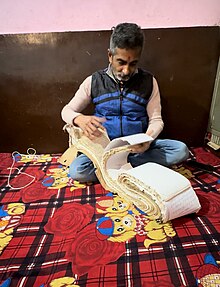Genealogy registers of families, maintained by Brahmin Pandits known locally as ‘Pandas’, who work as professional genealogists, at Haridwar, have been a subject of study for many years. In several cases, these voluminous records known as Vahis (Bahi), have also been used in settling legal cases regarding inheritance or property disputes, as these records are considered sacrosanct both by the pilgrims and the Pandas themselves, and many of these records trace family history, for more than twenty prior generations, stretching across many centuries.

As Haridwar has traditionally been a site for death rites and also Shraaddha amongst Hindus, it soon also became customary for the family pandits to record each visit of the family, along with their gotra, family tree, marriages, and members present, grouped according to family and hometown. Over the centuries, these registers became an important genealogical source for many families, especially after the Partition of India in 1947, and later amongst the Indian diaspora.
Hindu genealogy registers

Some notable places where Shraadhs are performed for the Pitrs are noted below. At these sites, it became customary for the family pandits (priest) to record each visit of the family, along with their gotra, family tree, marriages, and members present, grouped according to family and hometown. Over the centuries, these registers became an important genealogical source for many families, part of splintered families, in tracing their family tree and family history.
See also
References
- ^ Brahman pandas Divine Enterprise: Gurus and the Hindu Nationalist Movement, by Lise McKean, University of Chicago Press, 1996. ISBN 0-226-56010-4. Page 151.
- ^ Janasakhi Archived 24 March 2012 at the Wayback Machine Janamsakhis of Miharban and Mani Singh, Janamsakhi Tradition, Dr. Kirpal Singh, 2004, Punjabi University, Patiala. ISBN 81-7205-311-8. www.globalsikhstudies.net.page 169.
- Shoumatoff, Alex (13 May 1985). "The mountain of names". The New Yorker. p. 51. Retrieved 21 March 2018.
- The Greatest Mela on Earth, the Kumbh at Haridwar Rediff.com, "Tiny temples, hardly larger than phone booths, dot every 100 metres of the ghats. As do the umbrella-shaded stalls, standing on stilts, of the pandas, who apart from conducting religious ceremonies can track down the genealogy of Hindu families from their centuries-old, long, yellowing registers. Little ceremonies -- blessing of coconuts, offering of flowers, money and sweets, lighting of the oil lamps -- take place along every inch of the ghats and probably have for aeons. Pandas, alms seekers, pandits and hawkers are posted every few yards ready to shake out a few coins or notes from every newcomer they spot. Can I trace your family tree or offer you advice?"
- Who Do You Think You Are? BBC, "Meera's parents both originate from the farmlands of the Punjab, in north-west India. Her father, Surendra Syal, hails from a small village called Lasara. In India, it is difficult to trace your ancestry through documents like birth certificates, in the way that you can in the United Kingdom, but instead Indian family records are kept at shrines in the country's many holy cities. It is in the ancient city of Haridwar, on the riverbanks of the Ganges, that a Hindu priest is responsible for preserving the genealogy of the Syals, in a book called a Bah. It was in this book that Meera found that the Syals have been living in Lasara for the past 250 years."
Further reading
- The Hindu world: an encyclopedic survey of Hinduism, by Benjamin Walker, Published by Praeger, 1968.
- Tracing your Asian roots on the Indian subcontinent, By Abi Husainy, 2011-02-17, BBC
External links
[REDACTED] Media related to Haridwar at Wikimedia Commons
Categories: